The iPad Air Review
by Anand Lal Shimpi on October 29, 2013 9:00 PM ESTGPU Performance
Since the iPad Air uses the same A7 silicon as the iPhone 5s, it also uses the same on-die GPU as the 5s: IMG’s PowerVR G6430. This is a 4-cluster configuration of IMG’s latest graphics hardware, running at some relatively high frequency. I already went into some detail on the G6430 in our 5s review so I won’t rehash that here, but we’re basically looking at a shift to a more efficient scalar architecture.
I still don’t have confirmations of clock speeds, but I believe we’re looking at a max GPU clock of around 450MHz. As you’ll see from the results below, there’s a small difference in performance between the iPad Air and iPhone 5s in terms of peak GPU performance - implying very similar clocks. The difference is the iPad Air should be able to sustain its max frequency longer than the iPhone 5s can.
| Mobile SoC GPU Comparison | ||||||||||||
| PowerVR SGX 554MP4 | PowerVR G6430 | PowerVR G6430 | ||||||||||
| Used In | iPad 4 | iPhone 5s | iPad Air | |||||||||
| SIMD Name | USSE2 | USC | USC | |||||||||
| # of SIMDs | 32 | 4 | 4 | |||||||||
| MADs per SIMD | 4 | 32 | 32 | |||||||||
| Total MADs | 128 | 128 | 128 | |||||||||
| GFLOPS @ 300MHz | 76.8 GFLOPS | 76.8 GFLOPS | 76.8 GFLOPS | |||||||||
| GFLOPS as Shipping | 68.1 GFLOPS (?) | 115.2 GFLOPS | 115.2 GFLOPS | |||||||||
Since we’re talking about an A7 here and not an X-series SoC, there’s still only a 64-bit wide memory interface. As memory bandwidth is a key enabler of GPU performance I was curious to see how GPU performance compared to the outgoing iPad 4 with its much wider memory interface. Do keep in mind that the A7 does include a large system cache on-die, which can help improve effective memory bandwidth.
GFXBench 2.7
We'll start our GPU performance analysis with a look at low level results using GFXBench/GLBenchmark 2.7. The low level tests, particularly the offscreen ones, should give us some idea as to whether or not there's any increase in GPU frequency for the iPad Air vs. iPhone 5s implementations of A7.
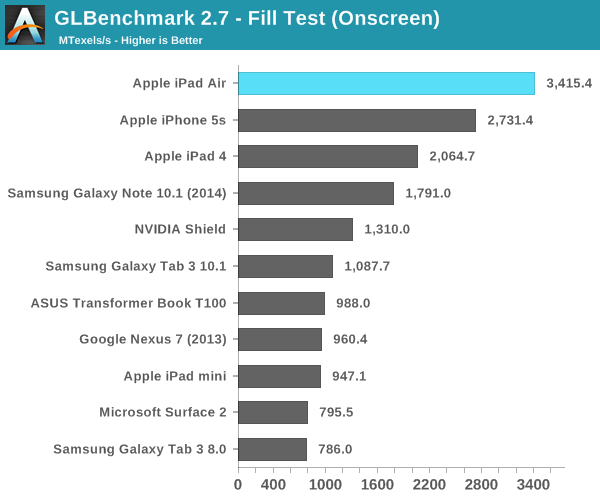
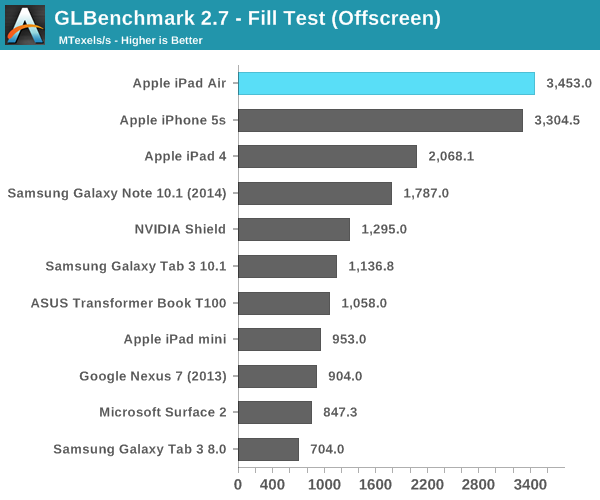
Looking at the fill rate results, there's a 4.5% increase in performance compared to the iPhone 5s. That could be the magnitude of clock increase that we're seeing between A7s. Apple could very well be relying on more thermal headroom in the iPad Air to provide any real world GPU performance advantages over the iPhone 5s.
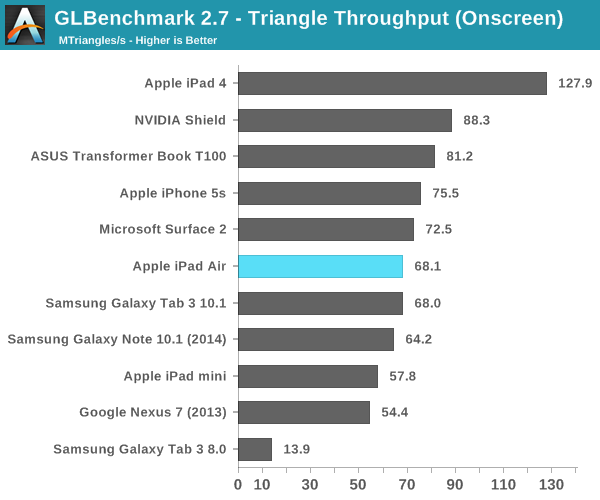

We see an even smaller gap between the Air and 5s in the triangle throughput tests (2.9%). There doesn't seem to be any substantial difference in GPU frequency between A7 implementations here. The regression in triangle rate performance compared to the iPad 4 is explained by differences in how Series 6 and Series 5XT GPUs scale in width. Whereas 5XT replicated nearly the entire GPU for "multi-core" versions, multi-cluster versions of Rogue only replicate at the shader array. The result? We don't see the same sort of peak triangle setup scaling we did back on multi-core 5XT parts. I'm not sure I'm particularly happy with the magnitude of the regression here, but I haven't seen any real world cases where it matters yet.
Next up are the game simulation tests. We'll start with the more strenuous of the two: T-Rex HD.
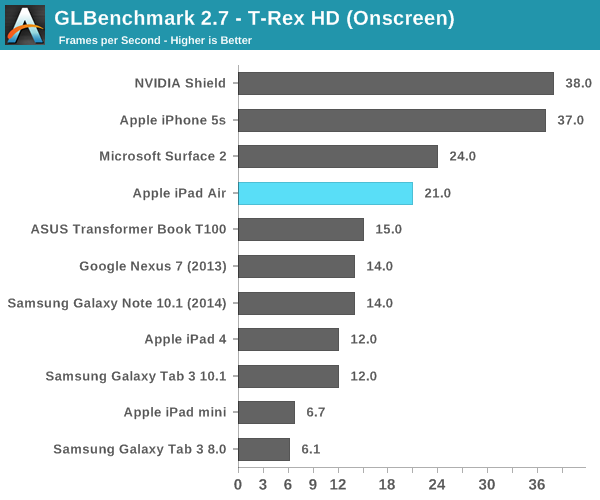
Here we get closer to Apple's claims of a 2x increase in performance. The iPad Air delivers 75% more performance than the iPad 4 in this test. Once again the iPhone 5s pulls ahead but that's because the onscreen tests render at display resolution, which is lower on the 5s.
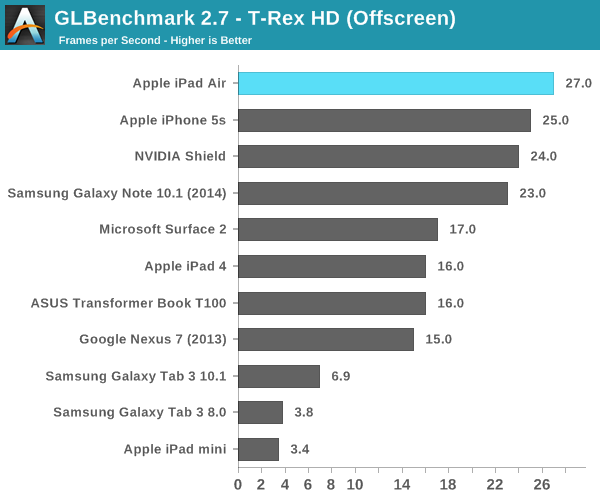
Offscreen performance sees similar scaling: ~69% better performance compared to the iPad 4.
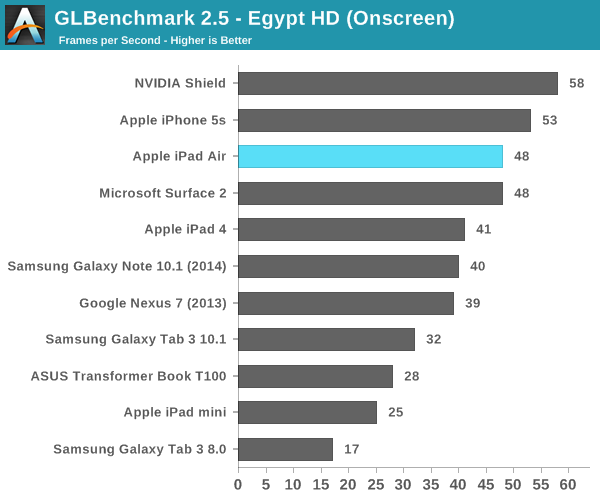
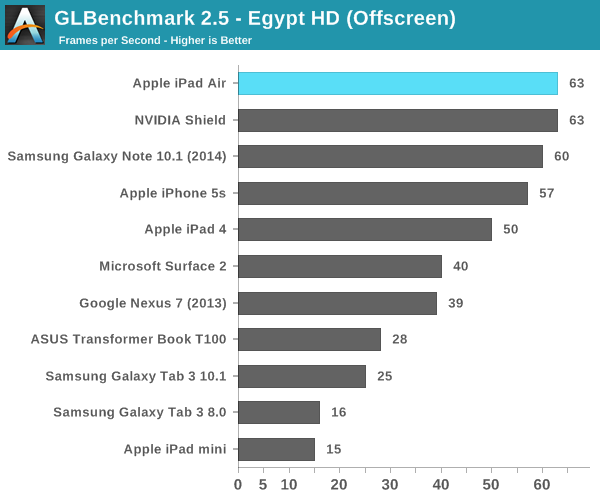
3DMark
We're once again running 3DMark's newest Unlimited mode which does its best to run independently of v-sync and at a standard resolution across all devices. I've also included 3DMark Extreme results below that feature a few more comparison points.
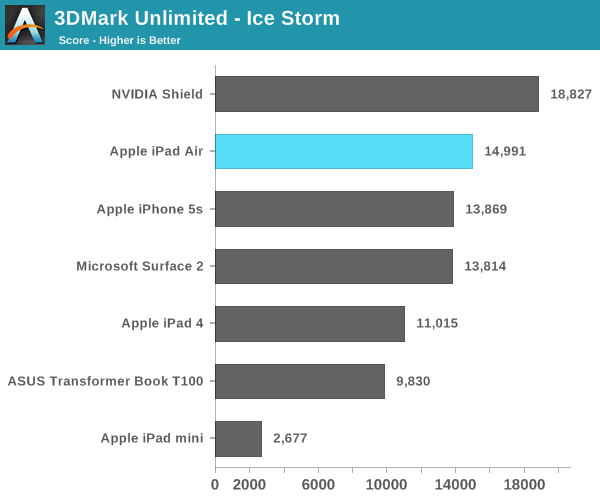
The overall Ice Storm scores show a 36% improvement in performance over the iPad 4 and an 8% increase compared to the iPhone 5s. Given the CPU frequency advantage of the A7 in the Air vs. the iPhone 5s, I'm guessing that's why we're seeing the performance gap we are here.
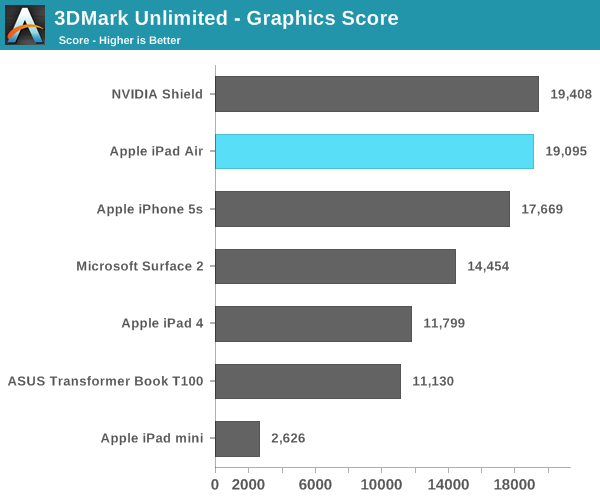
If we focus exclusively on the GPU tests (which themselves are still CPU bound), the iPad Air's performance advantage over the iPad 4 grows to over 60%.
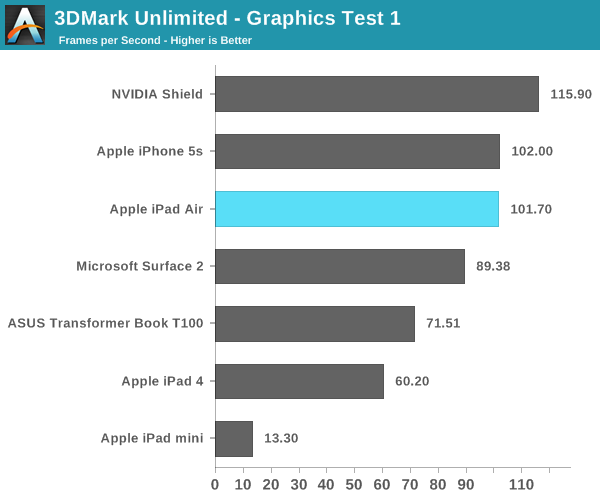
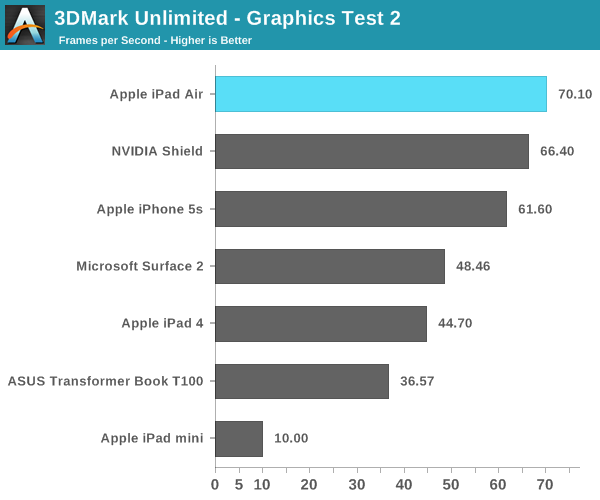
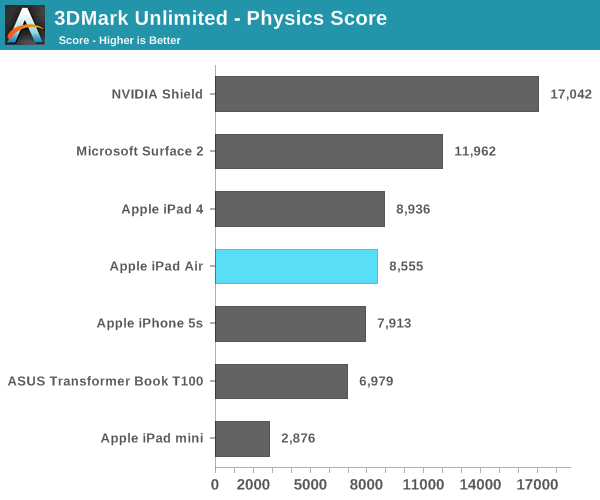
I'm still not entirely sure what's going on with the 3DMark Physics test, but we've seen this two reviews in a row now where Cyclone showed no performance increase at all compared to Swift despite this being largely a CPU test.
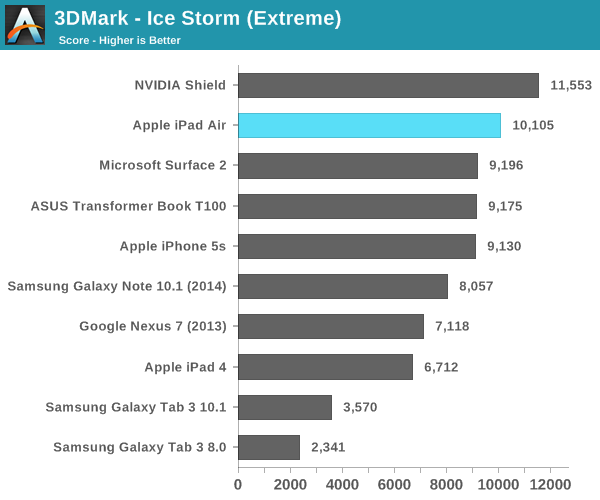
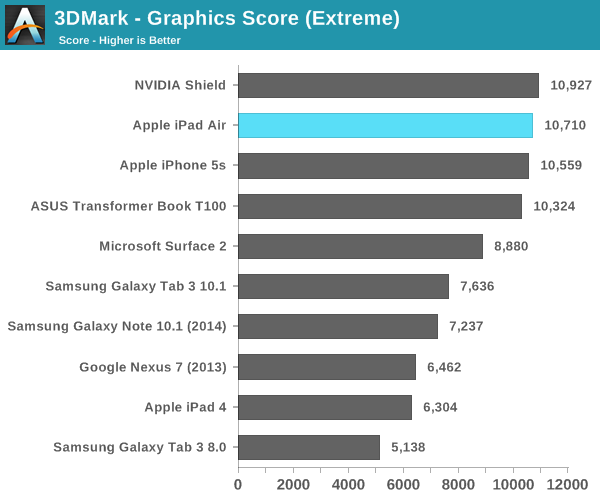
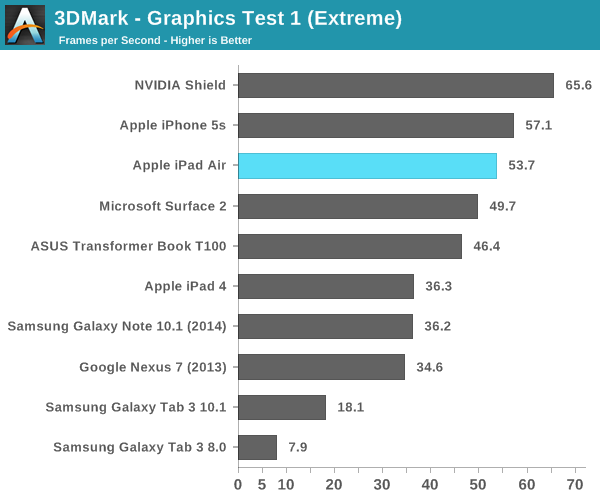
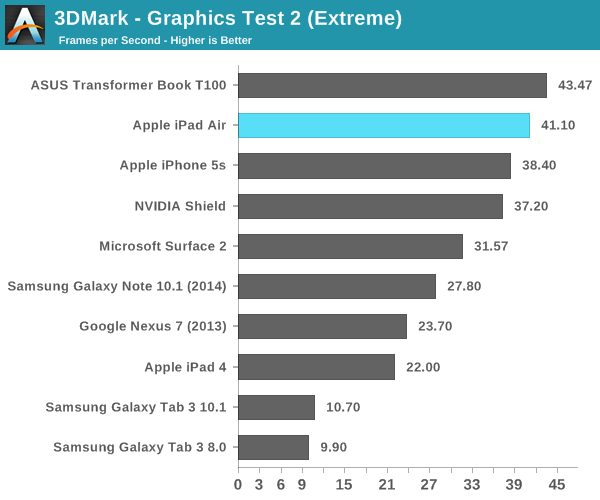

Basemark X
Basemark X is a new addition to our mobile GPU benchmark suite. There are no low level tests here, just some game simulation tests run at both onscreen (device resolution) and offscreen (1080p, no vsync) settings. The scene complexity is far closer to GLBenchmark 2.7 than the new 3DMark Ice Storm benchmark, so frame rates are pretty low.
I'm still having random issues with Basemark X reliably running both on and offscreen tests on iOS 7. Unfortunately I could only get onscreen results for the iPad Air, which came in at 46% faster than the iPad 4. Note the iPad mini and iPhone 5s benefit from having lower native resolutions here, which is why they perform so well.
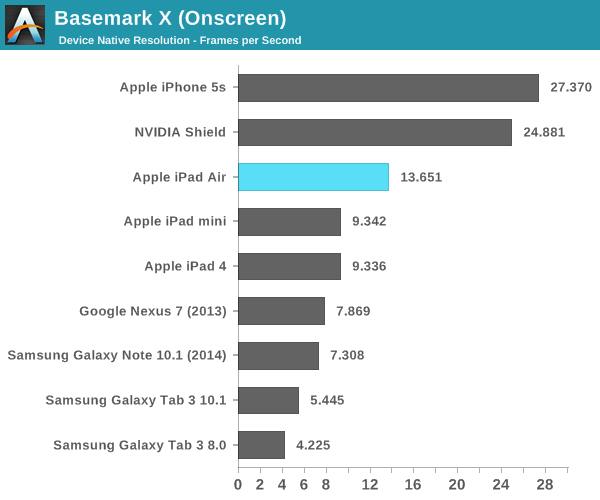










444 Comments
View All Comments
superflex - Friday, November 1, 2013 - link
You can cherry pick timeframes to make their stock look good.Over the last year, the stock is down 12%.
Janette - Saturday, November 2, 2013 - link
@dsumanik: Yeah, what @John2k13 said.whatsa - Sunday, November 3, 2013 - link
John,you didn't do to bad yourself- lmao
peterfares - Monday, November 4, 2013 - link
I'm sure if Apple implements NFC plenty of people will use it. So many people have Apple devices and you won't need to guess or remember if you can send things to each other. NFC is a bit of a mess right now. For contacts and URLs it's standard and should work between any device. But the big use case --files-- is a mess. On Android you basically can only send files between devices of the same manufacture. WP has file transfer standardized but it doesn't work with Android.Plus Apple users love to show people they have the latest Apple device and will love to beam things back and fourth.
Walkop - Tuesday, November 5, 2013 - link
You accuse this guy of bias (which he obviously is, alongside being totally ignorant to one of the best tech reviewers out there (MKB does incredible videos). But you have no idea what you're saying yourself with some areas, and you very clearly have a bias towards the iPad.Touch ID is the more of a gimmick than Haptic Feedback. I've used it on the Nexus 10; it makes a BIG DIFFERENCE in the feel of the onscreen keyboard. NFC is very useful if you know others with Android devices; I've used it on various occasions. Wireless charging is extremely convenient, especially if its on your desk and you use your phone on-and-off.
As for software; yes, the iPad hardware is considerably improved. But on the base level, the OS hasn't really been updated in years save for iOS7. That update added a lot of foward-facing changes, but not really too much functionality that hasn't been around already. iOS multitasking just got bumped up to be closer to Android, but still isn't nearly as flexible. Sharing is still difficult. You can't Bluetooth a group of PDFs to a friend (which I do weekly on my Android device), even!
Gesture Type. I CANNOT give this up. I can't stand typing on an iPad because the keyboard experience is so sub-par compared to my Nexus 10, and it will only improve with KitKat where you can swipe through the spacebar to combine multiple words in a single gesture.
You have apps, but so do Android tablets. There are many fantastic applications in every field that do their jobs admirably, and Google's set of tools are fantastic for writing, accessing information, sharing, and editing many formats of information. There aren't as many, but there are a lot of GOOD ones and even phone apps scale very well on a 10" display.
And the Nexus 10 2013 will very likely bring the most powerful non-Apple SoC to the table: Snapdragon 800. It matches or beats the Apple A7 in many areas, although it is defeated in others. Simply put, it is a VERY competitive chip with the A7 and, really, they are basically equal.
So please, stop bashing features that really DO matter to a lot of people, and I won't bash the iPad's lack of functionality (at a base level) when compared to Android devices out there. The iPad isn't the "perfect" device, neither is my Nexus 10. But we can't act like either is.
Brakken - Thursday, November 14, 2013 - link
Love your response.So tiring having thoughtless and random posts!
ivan256 - Wednesday, October 30, 2013 - link
That's a pretty uninspired list of proposed features.IMO, wireless charging is pointless. Is it really that hard to plug it in? How do you wireless charge while you're using it? It's added cost and size for trivial levels of added convenience.
USB3 sync would be fine, if it actually sped things up. I'm sure they'll get around to it. Who doesn't wireless sync these days though?
NFC would be another "me too" for a bandwaggon that is already slowing down. Really, think about the few places where NFC is catching on, and tell me you'd really use a 10" tablet in those situations. It would be almost as bad as the iPad-as-a-tourist-camera people.
Here are some better ideas:
Relaxing the iron fist - Let us install our own apps from outside the app store. If Apple wants to sign them first and charge a nominal fee so that they can "prevent piracy," so be it. But I want to install my own stuff. I want iOS to be able to participate in things like the Humble Bundle. I want more iOS OSS.
Location Spoofing. Let us set location services to lie to apps temporarily. This is useful for a variety of reasons ranging from development to privacy.
Home screen icon sizes. No further explanation needed.
Put the good camera on the front. Nobody should be using the rear facing camera in most situations, but you want good low-light performance in FaceTime and Skype. If they could figure out how to center the camera in the middle of the screen through some optics magic, that would be incredible.
Front facing speakers....
Most of this boils down to just making the thing something I don't feel like I need to jailbreak. It's hard to improve a device that is almost perfect.
dmunsie - Wednesday, October 30, 2013 - link
"Location Spoofing. Let us set location services to lie to apps temporarily. This is useful for a variety of reasons ranging from development to privacy."Developers can already do this, so what you are really asking is for privacy reasons. And in that case, Apple allows users to turn off location services on a per app basis already. I can tell you already that Apple is not going to allow users to spoof location data to any apps -- either you give an app accurate location data or no location data. Anything else puts their relationships with developers at risk -- for example, MLB would almost certainly pull their app if users could say they were in a different location since they wouldn't be able to enforce the blackout rules (I personally hate the blackout rules, but since they are legal agreements, MLB has to abide by them).
tigmd99 - Wednesday, October 30, 2013 - link
NFC? Dude, get updated! NFC (and Google Wallet) is a dying technology!!iBeacon and AirDrop are killing NFC.
algalli - Wednesday, October 30, 2013 - link
NFC is a dead issue. Most people have IBeacon which should be far more useful to stores and customers than NFC was ever intended to be. It is innovative if not yet widely recognized.